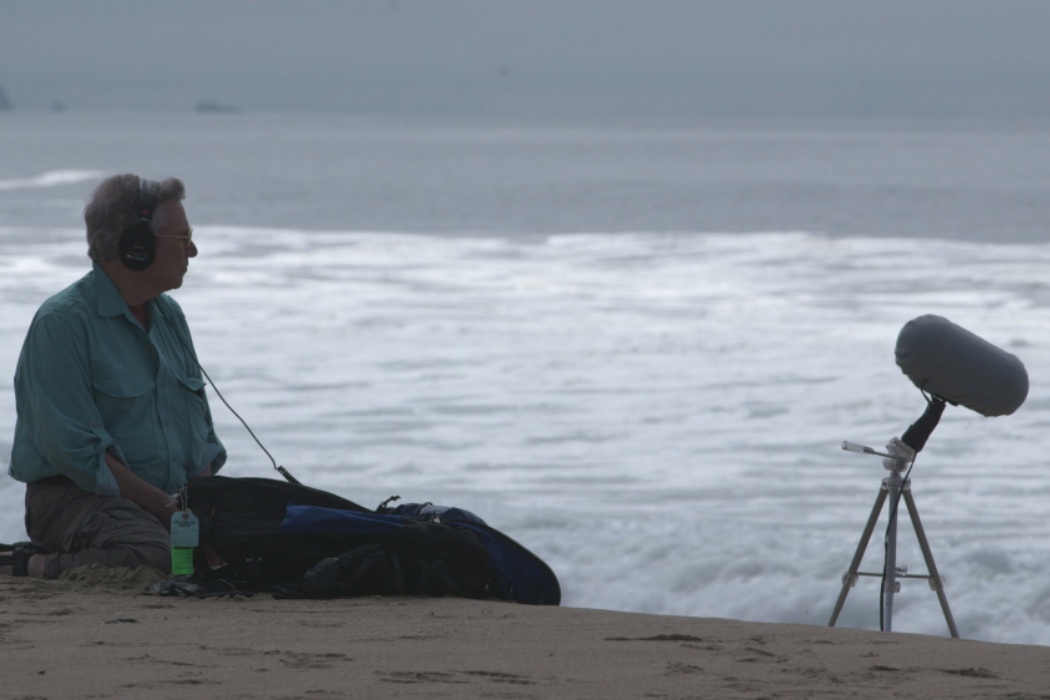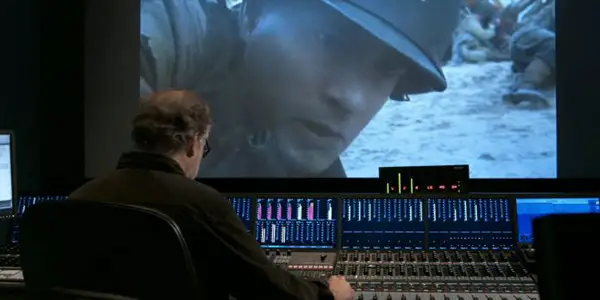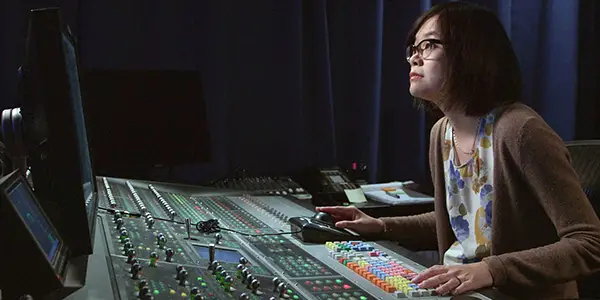MAKING WAVES: THE ART OF CINEMATIC SOUND: Sails (Mostly) Smooth

Jax is a filmmaker and producer, and a film &…
You purchase your ticket, get your popcorn, file into your row and settle down in your seat. Maybe it’s a recliner. The lights might already be slightly dimmed. After the previews, the main feature starts up and you are transported to a new world. Not only do your eyes take in the flickering light, but your ears, perhaps more sensitively attuned than they normally are, become filled with the ambience of the film’s environment, the particular sounds of the items, the voices of the characters, and the music which accompanied it all. How much awareness do we have of individual sounds, let alone entire soundscapes? It is often suggested that if the average viewer notices the sound (or lack of it, perhaps) then it is not doing its job. Whole teams, often led by a visionary individual, work countless hours to achieve invisibility. And it is these ghosts of cinema that Making Waves: The Art of Cinematic Sound celebrates.
This documentary brings together interviews with an impressive range of sound designers, sound editors, re-recording mixers, and directors, archive footage, and film footage both pre and post sound mix. Despite taking a relatively standard talking heads approach, first time director Midge Costin manages to keep the film fresh and more importantly, interesting. The freshman film covers a lot of ground without losing its audience and endeavours to represent both women and people of colour, despite a small hiccup (more on this in a moment).
Visualising Sound
The film is broken into sections, each one focusing on a new era of sound. Beginning with the advent of cinema, Making Waves follows the phenomenon of sound in film from the very first unsuccessful attempts to sync audio to a visual up through the most recent developments in the art form. Guided by some of the top people in the field, the film quickly covers everything from interesting trivia – for instance, though The Jazz Singer may have been the first “talkie” it was actually Don Juan starring John Barrymore that featured the first sync sound – to exploring the oft-debated balance between technical skill and art that exists in modern sound design and editing.
Walter Murch, Ben Burtt, and Gary Rydstrom provide a decent bulk of the interviews (and indeed both are heavily featured as major influencers on the field) and Murch in particular rather beautifully conveys the artistry of cinematic sound. There is a long-running debate in the industry over whether sound editing is a technical skill or an art form (and why can’t it be both?!); Murch goes out of his way to find artistic language to discuss the field and the documentary’s adaptation of his analogy of the sound team as an orchestra smacks of an intention to view sound artistically.

The use of the orchestral analogy manages to take the “illusory art” of sound and allow the average viewer to visualise it. The importance of this visualisation is not lost on Costin who works herself as a successful sound editor. The film picks up this analogy as its running theme, returning to an illustration of the sound department which mimics and orchestral half circle.
This allows Costin to take the intangible and often unthought of art of sound, and place it firmly in a cultural context that is easily and readily understood. Often the world of sound is simply presented as either too complex or too technical for anyone but an audiophile to care about learning more. This holds true even within the industry itself, where sound editing and mixing seems to be constantly on the chopping block at the Academy Awards broadcast. Many view it as “just” a technical skill (which in itself is an elitist attitude) and fail to see the artistry.
Sound As Art
Costin makes no buts about her view of sound as a creative endeavour. She certainly doesn’t shy away from discussing it as a technical achievement but the film’s focus rests largely on the artistic aspects of the field. She chooses interviews with heralded directors such as Steven Spielberg and David Lynch to accompany the interviews with sound crew, familiar voices of authority on filmmaking, who are emphatically supportive of the importance and emotional impact of sound. The film uses Saving Private Ryan as a primary to demonstrate both the emotionality of sound but also its use as a filmic device. This is an excellent choice for two reasons: most people, even if they have not seen the film, have seen clips or are at least aware of it, and the chosen clip is a perfect example of a director knowing when and how to use sound with intention to do so.

Even when discussing intricate technical applications of sound, such as the dialogue editing in Ordinary People, Costin frames it in an artistic context. The interviews (in this case with Victoria Rose Sampson, dialogue editor on the film and daughter of supervising sound editor Kay Rose, who become the first woman to win an Oscar in sound for her work on the film) highlight not only the mechanics of the edit but the emotional importance. For the particular film in question, it was actually silence which was used to convey the tension and the production footage was shot near an airport. The film wonderfully highlights how an incredibly detailed technical application of sound resulted in a beautifully emotional film.
As a bit of an aside, this is an excellent example of Costin’s use of archive footage – listening to the original playback of Ordinary People allows for an immediate comparison rather than relying on memories of the viewer. It allows Costin to ingratiate the film to the less educated viewer without condescension. This is something she handles well throughout the film, using small details such as the consistent appearance of name plates for interviewees rather than simply displaying them once.
Representation In Sound
The inclusion of interviews with sound editors and re-recording mixers like Victoria Rose Sampson, Cecelia Hall, Lora Hirschberg, Bobbi Banks, and Greg Hedgepath and directors like Ryan Coogler, Barbara Streisand, and Sofia Coppola may seem a small thing at first, but the film goes out of its way to offer representation, particularly for women, but also for people of colour.

The film manages to do this without creating too much of a spotlight which might be perceived to dim other important voices such as Murch’s. For instance, while the film gives people like Murch, Rydstrom, and Burtt their due, it also focuses on contributions from Barbra Streisand, who was instrumental in pushing sound forward. Many people cite Apocalypse Now as the first use of 5.1 surround sound but rarely, if ever, is A Star Is Born (or indeed Streisand) as the first use of stereo sound, and the film largely accredits this leap forward in technology to Babs herself. This is a huge step in the history of sound that is so often overlooked, so it’s fantastic to see Streisand held up alongside the other innovators.
This unfortunately leads me to the only sticking point. The film does such a great job promoting diversity, especially women, therefore it comes as a bit of a shock when suddenly an interview with John Lasseter, who left Disney at the end of last year in the wake of #MeToo allegations, pops up. He’s there to talk about Gary Rydstrom’s work on Pixar films, beginning with Luxo Jr., but as Rydstrom gives a lengthy interview himself, it doesn’t seem entirely necessary to include Lasseter. After finding such joy in the film taking care to hold up the women of sound as much as the men, this just feels like a bit of a slap in the face.
Making Waves: The Final Mix
Despite this small sore spot, the film overall comes together. It is ready to expertly guide the audio novice and there are some interesting surprises for even the seasoned audiophile. Though it rests primarily on talking heads, the editing of the interviews and graphics works with the content to carry the film along at a nice pace, breaking into new territory before one can get bored but not before you’ve found out what you needed to know. It would be unsurprising to see the film used for educational purposes in film sound classes for years to come, but even your average film buff will enjoy it.
What do you think about the power of sound in film? Let us know in the comments below!
Watch Making Waves: The Art of Cinematic Sound
Does content like this matter to you?
Become a Member and support film journalism. Unlock access to all of Film Inquiry`s great articles. Join a community of like-minded readers who are passionate about cinema - get access to our private members Network, give back to independent filmmakers, and more.
Jax is a filmmaker and producer, and a film & tv production lecturer at the University of Bradford and is also completing a PhD about Stan Brakhage at the University of East Anglia. In the remaining "spare time", Jax organises the Drunken Film Fest, binges bad TV, and dreams of getting “Bake Off good” with their baking.













